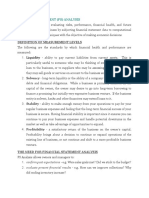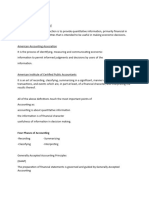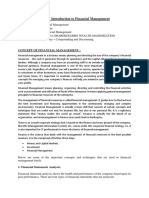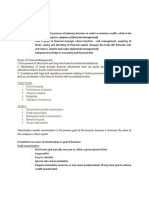Objective of Financial Management
Uploaded by
Meghan Kaye LiwenObjective of Financial Management
Uploaded by
Meghan Kaye LiwenObjective of Financial Management
A. Profit maximization
B. Wealth Maximization
To achieve wealth maximization, the finance manager has to take careful decision in respect of:
1. Investment Decisions:
-These relate to the selection of assets which funds will be invested by a firm.
2. Financing Decision
-These relate to acquiring the optimum finance to meet financial objectives and seeing that
fixed and working capital is effectively managed.
3. Dividend Decision
-These relate to the determination as to how much and how frequently cash can be paid out
of the profits of an organization as income for its owners/shareholders.
4. Liquidity Decisions
-Current asset management is another important function that requires that current assets
should be managed efficiently to guard the firm against illiquidity. Lack of liquidity in
extreme situations can lead to insolvency. A high rate of investment in current assets would
provide liquidity but would lose profitability. This trade-off must be managed effectively.
Financial Management and Accounting
Accounting is an important input in financial decision-making or into the financial
management function. The information contained in financial statements and reports helps
financial managers in gauging the past performance and future directions of the
organization.
Decision-making
The purpose of accounting is to collect and present financial data on the past, present and
future operations of the organization. The financial manager uses these data for financial
decision making. Financial management begins where accounting ends.
TEN AXIOMS THAT FORM THE BASICS OF FINANCIAL MANAGEMENT
1. The risk-return trade-off
2. The time value of money
3. Cash flows-not profit-is King
4. Incremental Cash Flows
5. The curse of competitive markets
6. Efficient Capital Markets
7. The agency problem
8. Taxes bias business decisions
9. All risk are not equal and some cannot-Some risk can be diversified away
10.Ethical behavior is doing the right thing, and ethical dilemmas are everywhere in finance
FINANCIAL STATEMENT ANALYSIS
Process of identifying financial strengths and weaknesses of the firm by properly
establishing relationship between the items of the statement of financial position and
the profit and loss account.
TOOLS AND TECHNIQUES OF FINANCIAL STATEMENT ANALYSIS:
1. Horizontal (Trend) Analysis
-Compares line items from one period with another period, to assess trends. Its purpose is
to determine the increase or decrease that has taken place, expressed as either an amount
or a percentage.
Increase/Decrease Method (For two accounting periods)
Peso change= Amt .∈Comaprison year− Amt .∈ Base year
Peso Change
%Change= ∗100
Amount ∈Base year
Trend Percentages or Index Numbers (For more than two years)
Amount∈Comaprison Year
Trend %= 100∗¿
Amount ∈Base Year
You might also like
- Financial Management Summary and FormulasNo ratings yetFinancial Management Summary and Formulas30 pages
- Toglia's Dynamic Interactional Approach To CognitionNo ratings yetToglia's Dynamic Interactional Approach To Cognition32 pages
- The Whole System of Double Entry Bookkeeping Can Be Summarised in The Following Two RulesNo ratings yetThe Whole System of Double Entry Bookkeeping Can Be Summarised in The Following Two Rules13 pages
- Introduction and Fundamental Tools of FinanceNo ratings yetIntroduction and Fundamental Tools of Finance11 pages
- BUS FIN Chapter 2_Review of FS Prep, Analysis and InterpretationNo ratings yetBUS FIN Chapter 2_Review of FS Prep, Analysis and Interpretation7 pages
- Financial Statements, Mis and Financial KpisNo ratings yetFinancial Statements, Mis and Financial Kpis2 pages
- Session 2 - by Catherine Rose Tumbali - PPTNo ratings yetSession 2 - by Catherine Rose Tumbali - PPT25 pages
- Financial Statement Analysis: Importance of Financial Statements100% (1)Financial Statement Analysis: Importance of Financial Statements14 pages
- Role of Financial Manager: Objective Is To AssessNo ratings yetRole of Financial Manager: Objective Is To Assess31 pages
- Learning Objectives: Review of Financial Statement Preparation: Analysis and InterpretationNo ratings yetLearning Objectives: Review of Financial Statement Preparation: Analysis and Interpretation4 pages
- Analysis and Interpretation of Financial StatementsNo ratings yetAnalysis and Interpretation of Financial Statements20 pages
- Chapter 1 - Introduction to Accounting in BusinessNo ratings yetChapter 1 - Introduction to Accounting in Business3 pages
- Why Is Financial Management So Important in BusinessNo ratings yetWhy Is Financial Management So Important in Business3 pages
- Unit 1 Introduction To Financial ManagementNo ratings yetUnit 1 Introduction To Financial Management12 pages
- Sample Compre Questions Financial ManagementNo ratings yetSample Compre Questions Financial Management6 pages
- why management accounting is called an essential tool for managementNo ratings yetwhy management accounting is called an essential tool for management26 pages
- Earnings Analysis for Stock Traders & Investors: Fundamental AnalysisFrom EverandEarnings Analysis for Stock Traders & Investors: Fundamental AnalysisNo ratings yet
- Factory Overhead Variances: Flexible Budget ApproachNo ratings yetFactory Overhead Variances: Flexible Budget Approach4 pages
- Standard Cost Under Absorption and Variable CostingNo ratings yetStandard Cost Under Absorption and Variable Costing4 pages
- Thai Real Estate Practitioners Template-BERACNo ratings yetThai Real Estate Practitioners Template-BERAC17 pages
- ISTJ Personality Type - Traits & Characteristics of Dutiful TypeNo ratings yetISTJ Personality Type - Traits & Characteristics of Dutiful Type10 pages
- DECISION MAKING Presentation in Nursing Leadership and Management100% (1)DECISION MAKING Presentation in Nursing Leadership and Management30 pages
- Assignment Brief - HND Level 4 - Unit 3 HRM50% (2)Assignment Brief - HND Level 4 - Unit 3 HRM4 pages
- Learning Activity 2. Decision-Making ProcessNo ratings yetLearning Activity 2. Decision-Making Process8 pages
- Manageria L Economics: Part 1 - IntroductionNo ratings yetManageria L Economics: Part 1 - Introduction16 pages
- Digital Supplier Selection Reinforcing Supply Chain Quality Management Systems To Enhance Firm's PerformanceNo ratings yetDigital Supplier Selection Reinforcing Supply Chain Quality Management Systems To Enhance Firm's Performance29 pages
- Research Evidence in The Humanitarian SectorNo ratings yetResearch Evidence in The Humanitarian Sector52 pages
- Intuition and Problem Solving: Jo M.C. NelissenNo ratings yetIntuition and Problem Solving: Jo M.C. Nelissen18 pages
- Business Intelligence in The Digital Economy Opportunities Limitations and Risks100% (3)Business Intelligence in The Digital Economy Opportunities Limitations and Risks310 pages
- Unit-I: Meaning of Test, Measurement and Evaluation50% (2)Unit-I: Meaning of Test, Measurement and Evaluation14 pages
- (FREE PDF Sample) Management An Introduction David Boddy Ebooks100% (1)(FREE PDF Sample) Management An Introduction David Boddy Ebooks53 pages
- OB Lecture 5 - Perception Individual Decision MakingNo ratings yetOB Lecture 5 - Perception Individual Decision Making29 pages
- Organisation Theory and Behaviour - P.K. Saxena - 2021 - University Science Press - 9789391162689 - Anna's ArchiveNo ratings yetOrganisation Theory and Behaviour - P.K. Saxena - 2021 - University Science Press - 9789391162689 - Anna's Archive280 pages








































































































